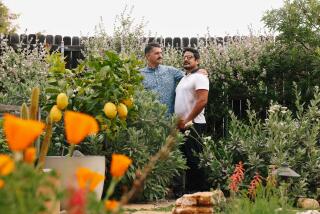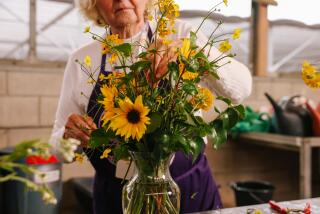Zinnias Evoke Memories of a First Love
- Share via
I’m thinking of taking out the rare salvias that I drove all the way to Santa Cruz to buy at the Cabrillo College plant sale (famous for its huge selection of salvias) and replacing them with zinnias.
Yes, common zinnias, the wild orange and cherry-red varieties that won this year’s All-America Selections gold medal. (Don’t confuse this program for annuals and vegetables with the All-America Rose Selections.)
The arrival of 1999’s glossy new seed catalogs prompted this somewhat irrational thinking.
I’ve got the perfect spot, right alongside the front entry path. It’s a narrow bed currently filled with salvias, zauschnerias and other uncommon droughty stuff.
This bed gets a full day of sun in summer and is seldom watered, but if I start watering it, the zinnias should do fine, and I wouldn’t mind a season of jolting zinnia color.
While the zauschnerias (commonly called California fuchsias) are as bright as can be in the fall, the salvias and other plants in this bed are a trifle subdued.
My very first garden was full of zinnias in wild Crayola colors. It was a rental property, a squat, turn-of-the-century box with a front porch. The place looked as if it was built for railroad workers (and was right across the street from the Southern Pacific tracks).
It was about to be condemned by the city when I made a deal with the owners that I would fix it up, if they’d rent it to me cheap. I fixed up the inside and then spilled out into the garden.
I tidied up the two camellias and two pittosporums on either side of the front porch, began pruning a tangled old Cecile Brunner climbing rose and started weeding the dead and dying Bermuda grass lawns.
In one spot under the rose, I hit something hard with the hoe and, while it didn’t quite rank with some of the great archeological accidental finds, I did find an ancient brick patio hiding under the grass.
With the lawns in shape, I turned my attention to the weedy beds that encircled them, planting loads of zinnias.
*
Perhaps that’s the spark that seed catalogs ignite whenever they show up in my mail slot--memories of a first garden that rate right up there with first love.
Seed catalogs arrive in the middle of winter when gardeners in snowbound climates are pining for spring. Perhaps because this year has seemed so cold even here, I find myself more vulnerable than normal to their flowery prose and rosy illustrations.
It is a gamble ordering seed of things you’ve never heard of--that no friend has grown, that you’ve never seen in nurseries or at botanic gardens or even found in references. But seed is still pretty cheap, although a modest order can quickly mount up.
For instance, 25 seeds of the new zinnia cost $2.95, more than a six-pack of petunias at the nursery.
But listen to the description: “When we grew these terrific new zinnias in our trials . . . the ‘oohs and aahs’ were deafening,” “The first flowers to be awarded this prestigious award in 10 years,” “Bushy plants (12 to 15 inches high and wide) are simply smothered nonstop all season long with cheerful 2-inch blooms,” and “This zinnia is highly tolerant of mildew and other foliar diseases.”
The pictures are captivating, but it was that last remark that got me filling out the order form.
*
I had already pretty much given up annuals for more exotic fare, but I stopped growing zinnias when I moved to West Los Angeles, where zinnias mildew badly.
The award-winning zinnia named ‘Profusion’ comes in orange or cherry. The two colors look like they should be planted several yards apart from each other, even being shown on separate pages in the catalog.
Maybe I’ll plant the cherry red with the new ‘Crimson Thriller’ sunflower shown a few pages later, or the striped morning glories named ‘Tie Dye’ and ‘Blue Silk’ that are pictured. There’s a low picket fence right behind this bed.
Perhaps I’ll mix the orange variety with spreading ‘Star Orange’ Zinnia angustifolia, which only grows to a foot tall, tops, with multitudes of inch-wide sunny flowers. It’s also new for 1999.
If they last until fall, these orange flowers should really look good with the orange-red zauschnerias, which, unlike the salvias, I have no intention of taking out.
*
Vegetables also win honors as All-America Selections. This year there’s a round zucchini, an oblong cherry tomato (which they say is easy to hold and slice), an icebox-sized watermelon and an even smaller pumpkin aimed at kids.
Pore over the many catalogs and you’ll find other new vegetable wonders, such as an extra-sweet corn with red kernels, an orange watermelon, a purple asparagus and a yellow carrot.
What do they taste like? That’s the gamble with new vegetable seed, but I think I’ll try the red corn just to see the expression on guests’ faces when it’s served up steaming hot. Where I’ll plant it, I’m not quite sure, since corn needs to be grown in blocks to pollinate, and it’s recommended that another extra-sweet corn be grown with this one for full pollination.
But order seed first, worry about where to plant it later. I suspect that’s the idea behind all those pretty catalog pictures and glowing descriptions, and the reason they mail catalogs in winter.
I, for one, fall for them every time.






